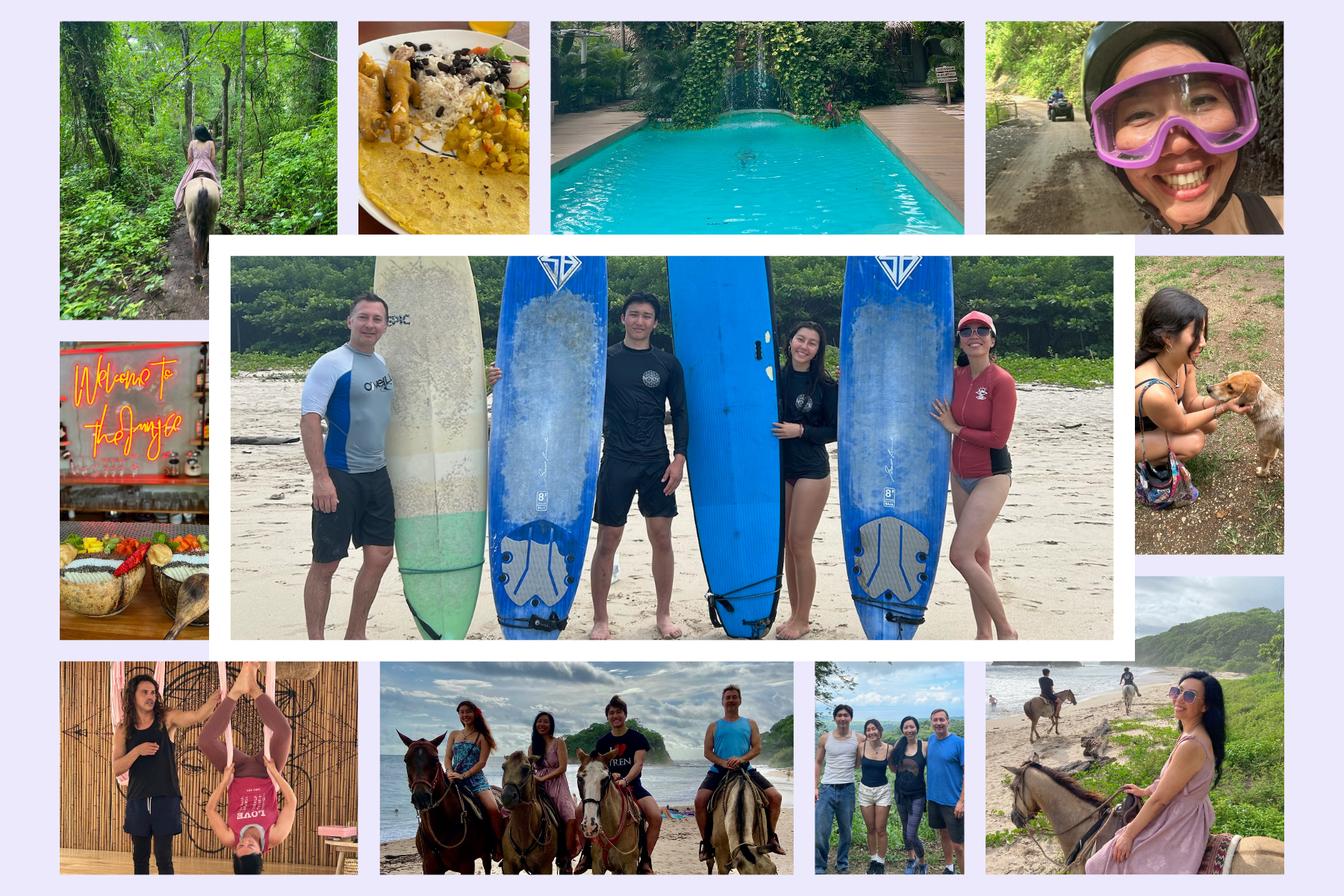Becoming the Next Blue Zone: Living Healthier and Fuller Lives
Written by Dr. Suzanne Tang
August 11th, 2024
We recently went on a relaxing and restorative vacation to Costa Rica to celebrate my husband’s 50th birthday and my daughter’s high school graduation. I typically research, analyze, and over-plan our trips months ahead; often filling up our travel itinerary with multiple daily activities. This time, I wanted to travel intentionally and mindfully to incorporate more rest, relaxation, and peaceful, quality family time together. I fortuitously stumbled upon a small surf and yoga hotel, Norte, in the small coastal town of Nosara off the Pacific Ocean. Nosara is known for its natural beauty, a plethora of yoga classes, clean eating, excellent surf, and healthy lifestyle. It also happens to be on the Nicoya Peninsula, an actual Blue Zone, which is one of five areas in the world with the highest density of centenarians, who are living healthy and long lives.
From recently watched documentaries, I already knew a few things about Blue Zones: that a healthy diet, physical activity, connection, community, spirituality, and purpose were primary elements of longevity and quality of life, which is not a surprise. Visiting a Blue Zone, even as a tourist, gave me so much more perspective. The people there were kind and friendly, exuding a contagious warmth and positivity. The beautiful beaches and surrounding lush jungles and mountains were captivating places to explore. Healthy eating can be a challenge while traveling but not in Nosara. Every morning, we ate a delicious, organic, and plant-based breakfast rich in vegetables, beans, whole grains, and fruit at our hotel. We found our zen in yoga classes and I even hung upside down in a playful aerial yoga class. Surfing with my family in Costa Rica was one of my bucket list items and I am thrilled to share that I have crossed this item off my list. I’ve tried surfing at our beaches in southern California but it seemed impossible as I would flounder in the frigid, overbearing waves while my anxiety mounted. The surf off the Nicoya peninsula was warm, gentle, and inviting. I was able to catch several waves for the first time with my patient and encouraging surf instructor.
I also learned that Nicoyan water has the highest amount of calcium and magnesium in Costa Rica, which could explain why the rates of osteoporosis and hip fractures are so low. Plus, Nicoyans eat little to no processed food and plenty of antioxidant rich vegetables and fruits. They also spend just 15% of what America does on health care and are more than twice as likely than Americans to reach a healthy age of 90 years.
One of our most memorable experiences was meeting 72-year-old coffee plantation farmer Vidal, who was fit and strong and didn’t look a day over 50. He lives and works on his rugged plantation farm alongside his children, grandchildren, and many adorable dogs. Along the plantation tour, Vidal would stop and chop sugar cane for us to chew on and he even made a walking stick for me because he wasn’t sure if I could keep up with him during the steep walk, ha! We sipped on their freshly home-brewed coffee that was so light and smooth (this is coming from a non-coffee drinker!) and shared a wholesome, farm-to-table meal prepared by his lovely daughters while his sweet grandchildren sang and played guitar. As a young boy, Vidal learned how to farm from his father, who lived to be 96 years old. Although it was a tour for us tourists, the family, their connection, and their purpose to live and work sustainably on their farm felt genuine and warm and fully embodied key elements of an actual Blue Zone. I could see how faith and family play a strong role in the Nicoyan culture and I felt a surge of inspiration within to further incorporate these healthy habits into my own family’s lives and write this newsletter to share with you.
Author, journalist, producer, and National Geographic explorer, Dan Buettner coined the term Blue Zones during an expedition to Okinawa, Japan to investigate the high rates of longevity there. Dan and his team of scientists continued their search for other Blue Zones across the world and have identified a total of 5 Blue Zones, thus far: Sardinia, Italy; the Seventh-Day Adventist community in Loma Linda, California; Ikaria, Greece; Nicoya Peninsula, and Okinawa, Japan.
They found that all Blue Zone areas share nine specific lifestyle habits with the potential to reverse-engineer longevity which they call the Power 9.
Power 9®
#1 Move Naturally - Instead of going to the gym and doing marathons people from the Blue Zones live in environments without modern conveniences or a housecleaning crew where they need to move with their daily activities, such as housework and yard work. The work that many centenarians do well past retirement age, by America’s standards, require high levels of physical activity. For example, in Sardinia, which is comprised of a community of shepherds, the men who live there walk five mountainous miles or more per day.
#2 Purpose - The Okinawans call it “Ikigai” and the Nicoyans call it “plan de vida” which translates to “the reason why I wake up in the morning.” Knowing your purpose extends your life expectancy by 7 years! What’s your why and purpose? I’ll share mine at the end of this newsletter.
#3 Downshift - Regardless of whether you live in a Blue Zone or not, there will be stress and stress leads to inflammation, which is a major contributing factor to chronic diseases. The world’s longest-living people have regular practices to reduce their stress, such as praying as the Adventists do, the Okinawan tradition of remembering ancestors daily, or enjoying happy hour like the Sardinians. Ikarians take a daily mid-afternoon break to nap or rest. People who take regular naps have up to 35% lower chances of dying from heart disease. Ikarians also eat a Mediterranean diet and live 8 years past life expectancy, experience 20% less cancer, half the rate of heart disease, and almost no dementia compared to Americans.
#4 80% Rule - Stop eating when you are 80% full. This stems from the Okinawan, 2500-year-old Confucian mantra, “Hara Hachi Bu”. My Chinese Medicine professor at Bastyr University also taught me this and it makes common sense to prevent overeating, digestive issues, obesity, and the chronic diseases associated with obesity. People in the Blue Zones also eat their smallest meal in the late afternoon and early evening and they do not eat for the rest of the evening, which is reminiscent of intermittent fasting. Studies show that intermittent fasting can reduce weight gain and inflammation, improve brain health and sleep, and regulate blood sugar, blood pressure, and cholesterol.
#5 Plant Slant - What do centenarians mostly eat? The answer is plants and legumes. Meat in small portions is eaten very sparingly about 5 times per month. After watching the Netflix docuseries, “Live to 100: Secrets of the Blue Zones” we noticed that purple sweet potatoes were a common food that the centenarians ate. This inspired us to include more purple sweet potatoes into our diet. Purple sweet potatoes are low-glycemic and rich in antioxidants, fiber, Vitamin A, Vitamin C, and potassium. Sadly the Blue Zones are beginning to shrink as more convenience stores, fast food chains, and processed foods infiltrate some of these areas.
#6 Wine @ 5 - People in all Blue Zones except for the Adventists drink alcohol moderately and regularly. The trick is to drink 1-2 glasses of wine daily with friends and with meals. Cannonau wine from Sardinia has 2-3 times the amount of heart-healthy flavonoids than other wines. However, if you don’t care for alcohol, have trouble with moderation, or notice that it affects your sleep, weight, or energy, skip this lifestyle habit.
#7 Belong - All but five of the 263 centenarians interviewed belong to a faith-based community regardless of the type of denomination. Research shows that attending faith-based services four times per month will add 4-14 years of life expectancy. The Adventists live 10 years longer than the rest of their North American counterparts.
#8 Loved Ones First - Families come first in the Blue Zones. Centenarians keep their aging parents and grandparents nearby or in the home, often commit to a life partner, and invest in their children with time and love. This focus on family was evident when seeing Vidal, the plantation farmer, and his multi-generational family living with him.
#9 Right Tribe - The longest-living people belong to social groups that support healthy behaviors. The Okinawans form moai, a group of five friends that commit to each other for the rest of their lives providing secure social networks. They meet daily to connect with one another. These safety nets lend financial and emotional support in times of need and give their members the stress-shedding security of knowing there is always someone there for them. Your friends’ habits can become your habits. The Framingham Studies show that smoking, obesity, happiness, and even loneliness are contagious. Furthermore, numerous studies have found that loneliness increases the risk of premature death and has the same mortality risk factor as smoking 10 cigarettes per day! Loneliness and social isolation are not only associated with increased depression, anxiety, and stress but they also increase the risk of heart disease, stroke, and dementia.
Can the rest of us incorporate these simple yet impactful lifestyle and dietary habits into our daily lives and transform our health to become the next Blue Zone? Absolutely! The Danish Twin Study established that only about 20% of how long the average person lives is dictated by our genes, whereas the other 80% is dictated by our lifestyle. Dan and his team have been taking their model of Power 9 across the US and implementing these health policies in our neighborhoods. They have seen amazing results in the small town of Albert Lea, Minnesota in just one and a half years, such as an 11% per year drop in student body mass index (BMI); a 3.2-year bump in life expectancy; the community lost a combined weight of 7280 pounds; and health care costs dropped by 40%!
This is where my passion and purpose lie. I’m here to inspire my family and community to take greater care of themselves through these powerful pillars of health and live in optimal wellness, connection, purpose, and fulfillment. Here’s to us taking the steps to become the next Blue Zone!
UPCOMING EVENTS
Yours in Wellness,
Dr. Suzanne Tang, ND, LAc
www.inspirenaturalwellness.net







